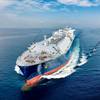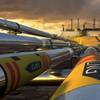Marine scientists and Louisiana officials are floating the idea of sinking some of Uncle Sam's cast-off ships along the water's edge to create a steel barrier against hurricane flooding.
The barrier would be made up of aging and obsolete tankers, research vessels and cargo ships.
Since Hurricane Katrina hit, Louisiana is looking at every option for shoring up its storm defenses especially quick fixes. Levees take years to build, and restoring lost marshes and cypress forests even longer.
The catastrophic flooding, St. Bernard officials say, was due in large part to a navigation channel that runs through the parish. Boasso said planting ships in the channel would go a long way to plugging what has been dubbed a "hurricane superhighway."
The channel, called the Mississippi River-Gulf Outlet, was dug in the 1960s as a shortcut between New Orleans and the Gulf of Mexico, but it soon turned into an environmental horror story. The waterway tripled in width as tides and ship wakes eroded its banks. The gulf's salt water encroached on cypress forest, swamp and marsh, killing an estimated 18,000 acres of marsh and 1,500 acres of cypress.
The channel did not spur much economic development, and today few ships use it.
For years, Louisiana has been trying to restore its dying wetlands with river diversions, marsh grass and other shoreline work. But that work has done little to stop the loss of wetlands about 2,000 square miles of it since the 1930s.
LSU's Kemp said he was unaware of ships ever being used as storm barriers.
Louisiana is looking at many options for saving its coast and blocking the gulf. Some are conventional, such as the construction of floodgates and levees.
Others are more obscure. For example, some scientists want to barge mud from the Midwest and dump it on southern Louisiana's sinking land.
source: AP
Subscribe for
Maritime Reporter E-News
Maritime Reporter E-News is the maritime industry's largest circulation and most authoritative ENews Service, delivered to your Email five times per week










